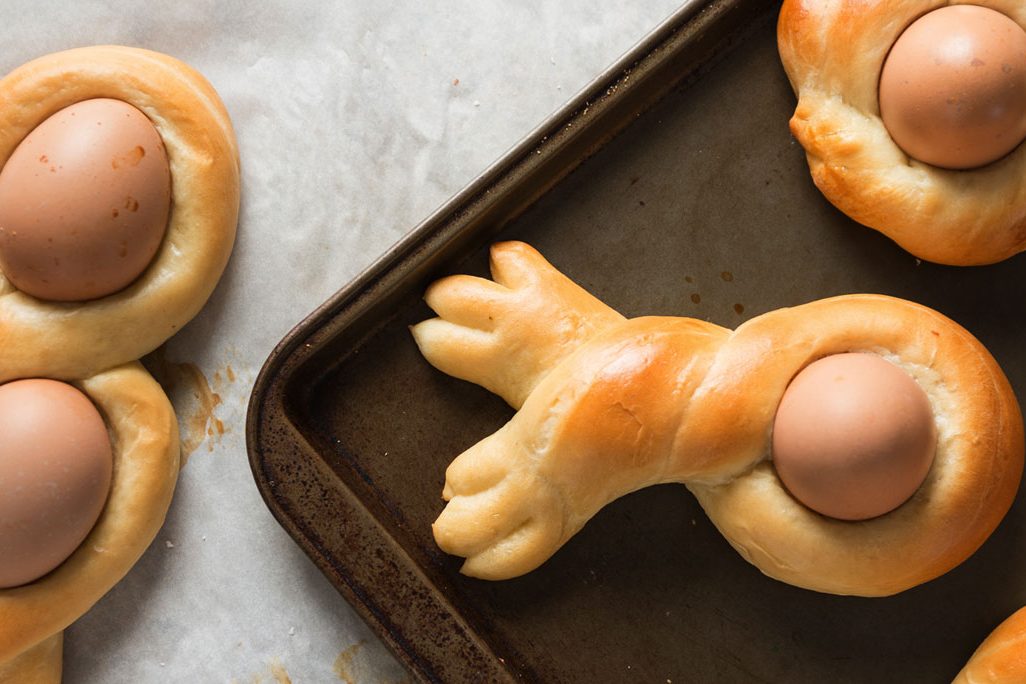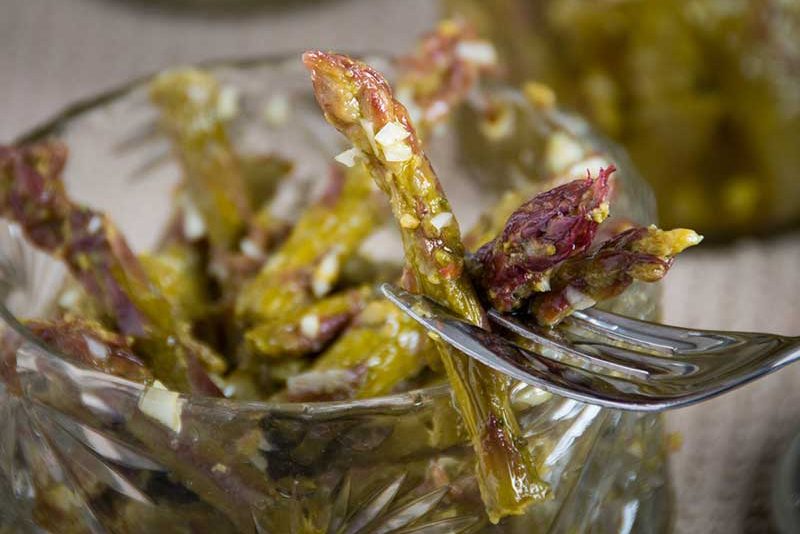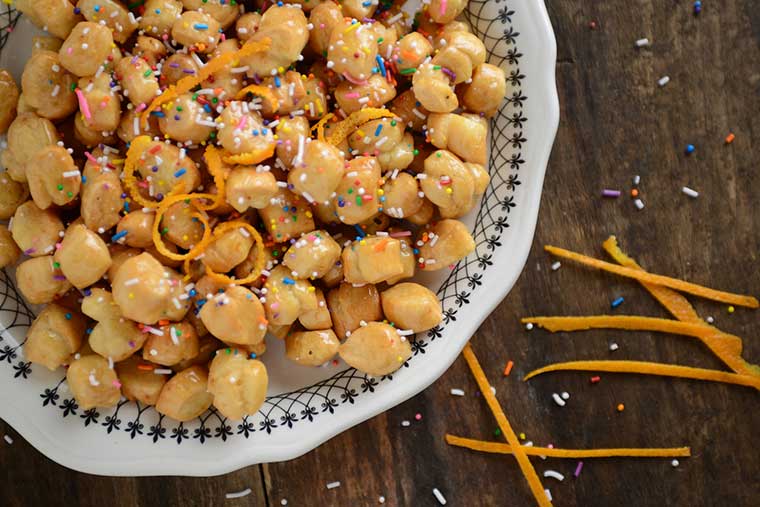Pasta e fagioli, or pasta and beans, is a classic dish found in most Italian households. Like many of the dishes that are now popular around the world, this was once a peasant dish in Italy. A very simple dish that is both high in fibre and filling! The preparation of pasta e fagioli varies greatly throughout Italy, as each region or town would use their most available ingredients. The two ingredients however that always remain the same are cooked beans and some sort of short pasta.
Recently, I asked my mom what she recalled of this dish growing up in Italy. She said this was made often as you needed to cook large batches to feed not only your own large family but also those that came to help work the land. It had to be something hearty and filling with readily available ingredients and of course not expensive to make. She remembers how they would grow their own wheat, harvest it, then take the grain to be milled into flour to make their pasta and bread. The leftover parts of the plant were stored as feed for the animals.
I often find myself thinking about how all of our parents and grandparents had to work so hard to gather the basic necessities to survive back in their impoverished times. Contrast how much we have today compared to how frugal they needed to be. Our parents’ hard work and determination has provided us with an amazingly lucky life. I encourage everyone to talk to their aging parents and/or relatives and record these precious stories to pass on to your kids.
Nonna Anna showed us her version of pasta e fagioli which uses the beans to make a sauce and a special cut of homemade pasta called ‘maltagliati’ or ‘badly cut’. Nonna Anna used home grown beans from her garden for this, but you can substitute canned or dry beans that have been cooked.
My dad recalls, as a youngster, that when it was pasta e fagioli for dinner, they would serve it up in long wooden platters. Everyone would have their assigned seats around the table and you would eat right from the platter BUT be sure not to start diving into your closest sibling’s portion! He also remembers that some would widen the tines on their forks in the hopes of grabbing more pasta with each bite! Sibling rivalry at its best!
Pasta e Fagioli – Pasta and Beans
Ingredients
Pasta
●3 cups all purpose flour + extra for work surface
●1 cup water
●1 large egg
Sauce
●2 litres canned tomato purée
●1 medium onion, cut into pieces
●1 celery stalk, cut into pieces
●1 carrot, cut into pieces
●1 tablespoon olive oil
●salt and pepper
●2 pounds pork hocks
●2 beef shanks (cut and dice meat into bite size pieces, discard bone and fat, boil shank meat in water for 2 minutes, drain, then rinse well)
●2 cans romano beans or equivalent fresh from garden or frozen
●Parmesan cheese, optional
To make the pasta
1. With a fork, beat the egg in a measuring cup. Then add water to a final volume of 1 cup.
2. Make a well with the flour on your work surface, add the liquid to the center and with your hands carefully incorporate the flour into the liquid, working from the inside out and being careful not to break the well wall.
3. Slowly incorporate all the flour and knead until you have a very smooth dough.
4. Wrap in food safe plastic wrap and place in refrigerator for 30 minutes.
5. Using a pasta rolling machine, roll small portions of dough at a time until you reach a thickness of about 2-3mm. Lay the rolled sheets of pasta on lightly floured and food safe cardboard, parchment paper or a clean tablecloth to dry. Because it is thicker, it will take a little longer to dry. Once it is dry enough that it doesn’t stick to itself, fold it to a 1 inch wide roll. Start at one end and with a knife cut small diagonal pieces. Separate pasta by fluffing with hands and place on cookie sheet or cardboard until you are ready to use.
To make the sauce
1. Heat 1 tablespoon of olive oil in a large pot. Add the onion, carrot and celery pieces and sauté for a few minutes.
2. Add the tomato purée and salt and pepper to taste.
3. Add the prepared shank meat to the pot and allow to cook in the sauce.
4. Let the sauce come to a boil, then cover and gently simmer for 2 hours. Stir often.
5. Thoroughly clean and then boil the pork hocks separately in water until the meat comes away from the bone. Discard the bones and any visible fat, dice the meat into small pieces and set aside.
6. If using canned beans, drain and rinse well then set aside. For frozen beans, cook them separately in salted boiling water for about 30 minutes then drain and set aside. You want them firm but cooked through.
7. About 15 minutes before the sauce is finished, put a cup of sauce in a pot with the cooked diced pork hocks. Gently heat through over low heat.
8. In a separate pot, do the same with the beans. Do not overcook or they will get mushy.
9. Discard the onion, carrot and celery pieces in the sauce.
10. Cook the pasta in plenty of salted boiling water being careful not to overcook.
11. Drain the pasta but reserve about 2 cups of the cooking water.
12. Put the drained pasta back into the empty cooking pot and immediately add as much sauce as desired and allow to cook together for a quick minute over low heat. Add some of the pasta water if too dry. This pasta is served a little more “liquidy” than regular pasta.
13. Quickly transfer to a large, shallow serving dish. Add more sauce on top of the pasta, add the prepared pork hocks and beans along with parmesan cheese and serve while piping hot.
Pasta e fagioli è un piatto classico che si consuma nella maggior parte delle famiglie italiane. Come molti dei piatti oggi popolari in tutto il mondo, una volta in Italia questo era un piatto contadino. Un piatto molto semplice che è sia ricco di fibre che saziante! La preparazione della pasta e fagioli varia notevolmente in tutta Italia, in quanto ogni regione o città utilizza gli ingredienti maggiormente a disposizione. I due ingredienti tuttavia che rimangono sempre gli stessi sono i fagioli cotti e un tipo di pasta corta.
Recentemente ho chiesto a mia madre cosa ricorda di questo piatto essendo cresciuta in Italia. Ha detto che spesso era fatto perché serviva cucinare grandi quantitativi per alimentare non solo la propria numerosa famiglia ma anche coloro che venivano per aiutare a lavorare la terra. Doveva essere qualcosa di abbondante e ricco di ingredienti facilmente disponibili e naturalmente non costoso da fare.
Ricorda come coltivavano il loro frumento, lo raccoglievano, poi portavano il grano da macinare in farina per fare la loro pasta e il pane. Le parti rimanenti della pianta erano conservate come mangime per gli animali. Mi ritrovo spesso a pensare a come tutti i nostri genitori e nonni hanno dovuto lavorare così duramente per disporre delle necessità di base per sopravvivere nei loro tempi di povertà. Contrasta con quanto abbiamo oggi e mostra quanto frugali erano costretti ad essere. Il duro lavoro e la determinazione dei nostri genitori ci hanno dato una vita incredibilmente fortunata. Incoraggio tutti a parlare con i propri genitori e/o parenti che invecchiano e a registrare queste storie preziose da trasmettere ai propri figli.
Nonna Anna ci ha mostrato la sua versione di pasta e fagioli. Lei usa i fagioli per fare una salsa e usa un taglio speciale di pasta fatta in casa chiamata ‘maltagliati’. Per questo piatto Nonna Anna ha usato fagioli di origine casalinga, presi dal proprio giardino, ma è possibile sostituirli con i fagioli in scatola o quelli secchi che poi sono stati cotti.
Mio padre ricorda che da giovane quando c’era pasta e fagioli per cena, questa veniva servita in lunghi piatti di legno. Tutti avevano posti assegnati intorno al tavolo e ciascuno mangiava dal piatto ma guai a cominciare a prendere dalla porzione del fratello più vicino! Ricorda inoltre che alcuni allargavano i denti delle loro forchette nella speranza di afferrare più pasta con ogni boccone! Il massimo della rivalità tra fratelli!
Pasta e Fagioli
Ingredienti
Pasta
● 3 tazze di farina più extra per la superficie di lavoro
● 1 tazza di acqua
● 1 uovo grande
Salsa
● 2 litri di puree di pomodoro in scatola
● 1 cipolla media, tagliata a pezzi
● 1 gambo di sedano, tagliato a pezzi
● 1 carota tagliata a pezzi
● 1 cucchiaio di olio d’oliva
● sale e pepe
● 2 chili di garretti di maiale
● 2 stinchi di manzo (tagliare e fare a dadi la carne in pezzi grossi come bocconi, scartare l’osso e il grasso, far bollire la carne in acqua per 2 minuti, scolare, sciacquare bene)
● 2 lattine di fagioli romani o equivalenti freschi da giardino, o congelati
● Formaggio parmigiano, facoltativo
Per fare la pasta
1. Con una forchetta, battere l’uovo in una tazza da misurazione. Quindi aggiungere acqua fino a un volume finale di 1 tazza.
2. Fare un pozzo con la farina sulla superficie di lavoro, aggiungere il liquido al centro e con le mani incorporare con cura la farina nel liquido, lavorando dall’esterno all’interno, facendo attenzione a non rompere il muro.
3. Incorporare lentamente la farina e impastare finché non si ha una pasta molto liscia.
4. Avvolgere in un involucro di plastica e collocare in frigorifero per 30 minuti.
5. Utilizzando una macchina per la pasta, fare piccole porzioni di pasta alla volta fino a raggiungere uno spessore di circa 2-3 mm.
6. Posare i fogli arrotolati di pasta su un cartoncino leggermente infarinato, carta pergamena o una tovaglia pulita per farla asciugare. Perché è più spessa, ci vorrà un po’ di più per asciugarla. Una volta che è abbastanza secca che non si attacca a se stessa, piegarla in un rotolo di 1 pollice. Iniziare da un’estremità e con un coltello tagliare piccoli pezzi diagonali. Separare la pasta modellandola con le mani e collocare sul foglio o il cartoncino fino a quando non si è pronti per usarla.
Per fare la salsa
1. Scaldare 1 cucchiaio di olio d’oliva in una grande pentola. Aggiungere la cipolla, la carota e i pezzi di sedano e cuocere per qualche minuto.
2. Aggiungere il puree di pomodoro, il sale e il pepe a piacere.
3. Aggiungere la carne di manzo preparata alla pentola e lasciare cuocere nella salsa.
4. Far bollire la salsa, quindi coprirla e farla bollire leggermente per 2 ore. Mescolare spesso.
5. Pulire accuratamente e poi bollire separatamente i garretti di maiale in acqua finché la carne non si stacca dall’osso. Scartare le ossa e qualsiasi grasso visibile, tagliare la carne in piccoli pezzi e mettere da parte.
6. Se si utilizzano i fagioli in scatola, scolarli e risciacquare bene, quindi metterli da parte. Per i fagioli congelati, cuocerli separatamente in acqua bollente salata per circa 30 minuti poi scolare e metterli da parte. Li dovete ottenere sodi ma cotti.
7. Circa 15 minuti prima che la salsa sia terminata, mettere una tazza di salsa in una pentola con i garretti di maiale cotti a dadini. Scaldate a fuoco dolce.
8. In un tegame separato, fate lo stesso con i fagioli. Non stracuocete o diventeranno molli.
9. Eliminare i pezzi di cipolla, carota e sedano nella salsa.
10. Cuocere la pasta in abbondante acqua salata bollente, prestando attenzione a non cuocere in eccesso.
11. Scolare la pasta ma conservare circa 2 tazze dell’acqua di cottura.
12. Mettere la pasta scolata nella padella di cottura vuota e aggiungere immediatamente la salsa desiderata e lasciare cuocere insieme per un minuto su fuoco lento. Aggiungere un po’ di acqua pasta se troppo secca. Questa pasta viene servita un po’ più liquida rispetto alla pasta regolare.
13. Trasferire rapidamente in un grande piatto da portata. Aggiungere altra salsa in cima alla pasta, aggiungere i garretti di maiale e i fagioli preparati con formaggio parmigiano e servire mentre è caldo.































